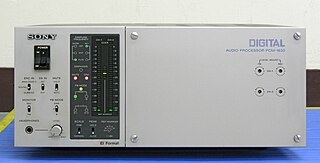
Analog television is the original television technology that uses analog signals to transmit video and audio. In an analog television broadcast, the brightness, colors and sound are represented by amplitude, phase and frequency of an analog signal.

Chrominance is the signal used in video systems to convey the color information of the picture, separately from the accompanying luma signal. Chrominance is usually represented as two color-difference components: U = B′ − Y′ (blue − luma) and V = R′ − Y′ (red − luma). Each of these difference components may have scale factors and offsets applied to it, as specified by the applicable video standard.

The National Television System Committee (NTSC) developed the analog television format encoding system that was introduced in North America in 1954 and stayed in use until digital conversion. It is one of three major analog format television standards, the others being PAL and SECAM. All the countries using NTSC are currently in the process of conversion, or have already converted to the ATSC standard, or to DVB, ISDB or DTMB.

Phase Alternating Line (PAL) is a colour encoding system for analogue television. It was one of three major analogue colour television standards, the others being NTSC and SECAM. In most countries it was broadcast at 625 lines, 50 fields per second, and associated with CCIR analogue broadcast television systems B, D, G, H, I or K. The articles on analog broadcast television systems further describe frame rates, image resolution, and audio modulation.

Video is an electronic medium for the recording, copying, playback, broadcasting, and display of moving visual media. Video was first developed for mechanical television systems, which were quickly replaced by cathode-ray tube (CRT) systems which, in turn, were replaced by flat panel displays of several types.

Interlaced video is a technique for doubling the perceived frame rate of a video display without consuming extra bandwidth. The interlaced signal contains two fields of a video frame captured consecutively. This enhances motion perception to the viewer, and reduces flicker by taking advantage of the phi phenomenon.

Telecine is the process of transferring film into video and is performed in a color suite. The term is also used to refer to the equipment used in the post-production process. Telecine enables a motion picture, captured originally on film stock, to be viewed with standard video equipment, such as television sets, video cassette recorders (VCR), DVD, Blu-ray Disc or computers. Initially, this allowed television broadcasters to produce programmes using film, usually 16mm stock, but transmit them in the same format, and quality, as other forms of television production. Furthermore, telecine allows film producers, television producers and film distributors working in the film industry to release their productions on video and allows producers to use video production equipment to complete their filmmaking projects. Within the film industry, it is also referred to as a TK, because TC is already used to designate timecode. Motion picture film scanners are similar to telecines.

Advanced Television Systems Committee (ATSC) standards are an American set of standards for digital television transmission over terrestrial, cable and satellite networks. It is largely a replacement for the analog NTSC standard and, like that standard, is used mostly in the United States, Mexico, Canada, and South Korea. Several former NTSC users, in particular Japan, have not used ATSC during their digital television transition, because they adopted their own system called ISDB.

Component video is an analog video signal that has been split into two or more component channels. In popular use, it refers to a type of component analog video (CAV) information that is transmitted or stored as three separate signals. Component video can be contrasted with composite video in which all the video information is combined into a single signal that is used in analog television. Like composite, component-video cables do not carry audio and are often paired with audio cables.
Broadcast television systems are the encoding or formatting systems for the transmission and reception of terrestrial television signals.
In video technology, 24p refers to a video format that operates at 24 frames per second frame rate with progressive scanning. Originally, 24p was used in the non-linear editing of film-originated material. Today, 24p formats are being increasingly used for aesthetic reasons in image acquisition, delivering film-like motion characteristics. Some vendors advertise 24p products as a cheaper alternative to film acquisition.
Deinterlacing is the process of converting interlaced video into a non-interlaced or progressive form. Interlaced video signals are commonly found in analog television, digital television (HDTV) when in the 1080i format, some DVD titles, and a smaller number of Blu-ray discs.
1080i is a combination of frame resolution and scan type. 1080i is used in high-definition television (HDTV) and high-definition video. The number "1080" refers to the number of horizontal lines on the screen. The "i" is an abbreviation for "interlaced"; this indicates that only the odd lines, then the even lines of each frame are drawn alternately, so that only half the number of actual image frames are used to produce video. A related display resolution is 1080p, which also has 1080 lines of resolution; the "p" refers to progressive scan, which indicates that the lines of resolution for each frame are "drawn" on the screen in sequence.

576i is a standard-definition digital video mode, originally used for digitizing analog television in most countries of the world where the utility frequency for electric power distribution is 50 Hz. Because of its close association with the legacy color encoding systems, it is often referred to as PAL, PAL/SECAM or SECAM when compared to its 60 Hz NTSC-colour-encoded counterpart, 480i.

A PCM adaptor is a device that encodes digital audio as video for recording on a videocassette recorder. The adapter also has the ability to decode a video signal back to digital audio for playback. This digital audio system was used for mastering early compact discs.
MUSE, commercially known as Hi-Vision was a Japanese analog HDTV system, with design efforts going back to 1979.

PAL-M is the analogue TV system used in Brazil since 19 February 1972. At that time, Brazil was the first South American country to broadcast in colour. Colour TV broadcast began on 19 February 1972, when the TV networks Globo and Bandeirantes transmitted the Caxias do Sul Grape Festival. Transition from black and white to colour, however, was not complete until 1978. Two years later, in 1980, colour broadcast nationwide in Brazil was commonplace.
Television standards conversion is the process of changing a television transmission or recording from one video system to another. Converting video between different numbers of lines, frame rates, and color models in video pictures is a complex technical problem. However, the international exchange of television programming makes standards conversion necessary so that video may be viewed in another nation with a differing standard. Typically video is fed into video standards converter which produces a copy according to a different video standard. One of the most common conversions is between the NTSC and PAL standards.

Rec. 709, also known as Rec.709, BT.709, and ITU 709, is a standard developed by ITU-R for image encoding and signal characteristics of high-definition television.
High-definition television describes a television system providing a substantially higher image resolution than the previous generation of technologies. The term has been used since 1936; in more recent times, it refers to the generation following standard-definition television (SDTV), often abbreviated to HDTV or HD-TV. It is the current de facto standard video format used in most broadcasts: terrestrial broadcast television, cable television, satellite television and Blu-ray Discs.










